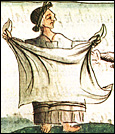| |
Market vendors selling tomatoes, beans, and cloth. Florentine Codex, (Med. Palat. 220, cc. 49v, 51, 55). Biblioteca Medicea Laurenziana, Florence, Italy, 1979. Permission for reproduction granted by Ministero Per I Beni Culturali e Ambientali.

|
|
THE MARKETPLACE
 he great Aztec marketplace of Tlateloco served as the central business center of Mexico and attracted 25,000 buyers and sellers every day. Goods of every description were displayed in organized rows. Products one could purchase included gold, exotic feathers, jaguar skins, maize, cacao, hairless dogs, earthenware, building planks, paper made from bark, and obsidian knives. The market had apothecaries and barbershops. Food stalls offered maize stews and tamales.
he great Aztec marketplace of Tlateloco served as the central business center of Mexico and attracted 25,000 buyers and sellers every day. Goods of every description were displayed in organized rows. Products one could purchase included gold, exotic feathers, jaguar skins, maize, cacao, hairless dogs, earthenware, building planks, paper made from bark, and obsidian knives. The market had apothecaries and barbershops. Food stalls offered maize stews and tamales.
In rural areas, weekly markets rotated from village to village to serve social as well as economic needs by bringing together people who normally lived in dispersed settlements. Marketplaces provided a setting for young men and women to meet and for marriages to be arranged.
|


